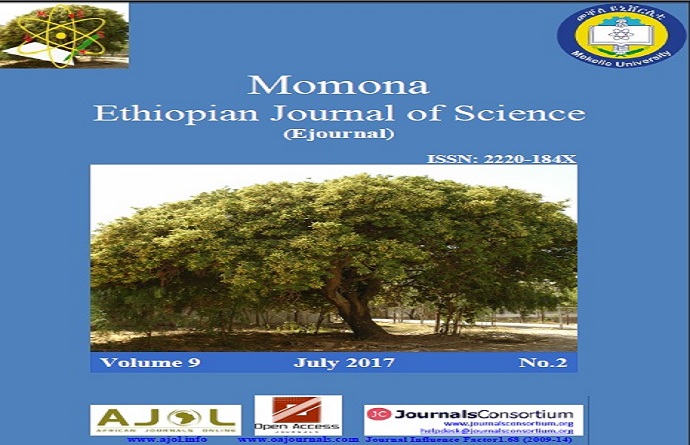Effect of Combined Application of Organic and Mineral Nitrogen and Phosphorus Fertilizer on Soil Physico-chemical Properties and Grain Yield of Food Barley (Hordeum vulgare L.) in Kaffa Zone, South-western Ethiopia
Abstract
Low soil fertility is one of the major factors limiting the yield of barley in Kaffa Zone, south-western Ethiopia. The problem is more severe in the Zone due to soil erosion and nutrient leaching caused by heavy and continuous rainfall. Thus, field experiment was conducted to assess the effect of combined organic and mineral nitrogen (N) and phosphorus (P) on selected soil physico-chemical properties and on grain yield of food barley in Ghimbo and Adiyo districts, south-western Ethiopia. Fourteen treatments comprising two organic fertilizer rates, i.e. 2.5 and 5 t ha−1 of Farm Yard Manure (FYM) and Vermicomost (VC) combined with three levels of mineral NP (25, 50 and 75% of recommended rates of NP), 100% recommended rate of inorganic NP (23 kg N ha-1 and 46 kg P2O5 ha-1) and no fertilizer application (control) in randomized complete block design on clay soil in Ghimbo and clay loam soil in Adiyo with three replications. Results indicated that the application of FYM in combination with different levels of recommended rates of inorganic N and P significantly improved most of the soil physico-chemical properties and significantly increased the grain yield of food barley over the application of 100% mineral NP alone and the control. The application of 5 t FYM ha−1 in combination with 75% recommended rates of inorganic N and P (17.25 kg N ha-1 and 34.5 kg P2O5 ha-1) was found to be superior and increased soil organic carbon content by 36 and 44.6%, available P by 70.5 and 78.2%, available K by 42.5 and 26.3%, and increased yield of barley by 76.8 and 83.5% in Adiyo and Ghimbo, respectively, over the application of 100% recommended rate of inorganic N and P only. Therefore, it can be concluded and recommended that the application of 5 t FYM ha−1 in combination with 75% of the recommended rates of inorganic N and P (17.25 kg N ha-1 and 34.5 kg P2O5 ha-1) can improve soil fertility and can increase yield of food barley in the study area.
Downloads
References
Amede, T & Takele, B. 2001. Reversing the degradation of arable land in Ethiopian Highlands. Managing African Soils: No. 23. IIED- London.
Bationo, A., Fairhurst, T., Giller, K., Kelly, V., Lunduka, R., Mando, A., Mapfumo, P., Oduor, G., Romney, D., Vanlauwe, B., Wairegi, L & Zingore, S. 2012. Handbook for Integrated Soil Fertility Management. Africa Soil Health Consortium, CAB International.
Berhane Lakew, Hailu Gebre & Fekadu Alemayehu. 1996. Barley production and research. In: G. Hailu and J. van Leur (eds.), Barley Research in Ethiopia. Past work and future prospects. Proceedings of the First Barley Review work shop, 16- 19 October 1993. Addis Ababa, Ethiopia.
Bhatacharyya, R., Kundu, S., Prakash, V & Gupta, H.S. 2008. Sustainability under combined application of mineral and organic fertilizers in a rain-fed soybean-wheat system of the Indian Himalayas. European Journal of Agronomy, 28: 33-46.
Chilot, Y., Berhane, L & Fekadu, A. 2002. On-farm evaluation of food barley production packages in the highlands of Wolemera and Degem, Ethiopia. pp 176–187, In: K. Gemechu, G. Yohannes, B. Kiflu, Y. Chilot and D. Asgelil (Eds.). Towards Farmer Participatory Research: Attempts and Achievements in the Central Highlands of Ethiopia.
More inside the PDF
Copyright (c) 2018 Momona Ethiopian Journal of Science

This work is licensed under a Creative Commons Attribution 4.0 International License.
COPYRIGHT AND LICENSE POLICY
The Momona Ethiopian Journal of Science accepts the manuscripts for consideration with the understanding that the manuscript has not been published and is not under consideration for publication elsewhere. Only original articles will be considered for publication if they have been published previously as abstracts, but not if they have been published previously as extended abstract (>1000 words). This applies to both electronic and print versions of the journal. The authors should assign copyright ownership to the Editorial Office of MEJS in the event that the manuscript is accepted for publication in the Momona Ethiopian Journal of Science. All accepted manuscripts must be accompanied by a copyright statement signed by all authors. A copy of the copyright form will be supplied along with the final reviewed version of the manuscript that is sent for final proof- reading. Authors may make multiple copies of the form if necessary and send to the Editorial Office with author’s signature(s) even individually.
All articles published by Momona Ethiopian Journal of Science (MEJS) are Open Access under the Creative Commons Attribution License (http://creativecommons.org/licenses/by/4.0). Under this license, authors retain ownership of the copyright for their content, and anyone can copy, distribute, or reuse articles as long as the author and original source are properly cited. In all these cases for re-use, the authors will be given proper credit to the original publication in MEJS.
